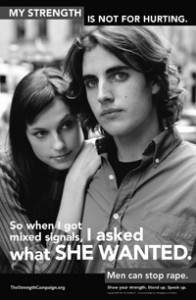 When you have endured violence at the hands of a man, it is easy to turn your fear and anger toward men in general—especially if you have been hurt multiple times. Suddenly, you start seeing every man as a perpetrator, an abuser, or at the very least someone not to be trusted. You see your experiences with men in your own personal life becoming a microcosm of the violence against women that happens on a societal level. In short, you lose hope in mankind.
When you have endured violence at the hands of a man, it is easy to turn your fear and anger toward men in general—especially if you have been hurt multiple times. Suddenly, you start seeing every man as a perpetrator, an abuser, or at the very least someone not to be trusted. You see your experiences with men in your own personal life becoming a microcosm of the violence against women that happens on a societal level. In short, you lose hope in mankind.
This was my experience for many years. When I began to share my story as an FFL speaker, I thought I was doing it for me, as part of my healing journey — and I was. What I never thought would happen, though, was that my hope in mankind would be restored.
I was awestruck as men began not only attending my talks, but asking questions — a lot of them. In every state I visited, at every university that hosted my lecture, men lined up to ask more: about the issue of violence against women, about how to help their loved ones, about what they could do to stop it, and about how it related to violence against the unborn.
College-aged men were planning my events, organizing their pro-life student groups to bring a talk like mine to their campus. It was a bold move. I realized then that these issues must be men’s issues, too.
* * *
Feminists have long acknowledged male privilege — the invisible rights, viewpoints, and protections men enjoy in our society simply because of their gender. For example, economic markets cater to the stereotypical desires of men, as when women’s bodies are used to promote everything from alcohol to cars to office equipment. Ask yourself next time you look at an advertisement: Whom does this ad target? If it is for women, it is most often a product that increases her “sex appeal” or promotes stereotypical roles for women (housecleaning is a prime example).
In the job market, men are paid more and offered more opportunities for advancement, sometimes without conscious thought — all instances of male privilege. Men disproportionately lead in many industries, sectors, and workplaces, such as schools, government, law enforcement, and entertainment, leaving women out of critical decision-making. Conversely, women in our society face objectification, higher rates of assault and victimization, and a ruthless climb up the corporate ladder.
All of these conditions form a breeding ground for violence against women. Objectification leads to sexualization. Leaving women out of positions of power diminishes accountability. Lack of accountability leads to a shift in attitudes in the public opinion. Places where men traditionally congregate (dorm rooms, locker rooms, offices, barber shops, etc.) can help spread those attitudes. Case in point: pornography. The sex trade is the world’s second largest industry (second only to the arms industry), and firearms and pornography are important parts of the sex trade. In the U.S., as the porn market has flourished, the line between “soft porn” and what is viewed as a “provocative” ad has blurred. The age at which girl’s bodies are sexualized continues to lower. This has occurred as a combination of over-sexualization and profit-driven decisions about the sale of women’s bodies has thrived. Society simply accepts it because “sex sells.”
Additionally, sexual violence and male dominance define porn. When women’s bodies are promoted as objects of sexual violence within a culture with little accountability and are then marketed, violence against women rises, and a “blame the victim” attitude flourishes. Questioning the (most often female) victim ’s clothes, actions, and reputation is reflective of a society that has devalued women.
All forms of violence against women reflect this devaluing of women and girls. Women have been fighting for generations, and although we have made great strides, violence against women remains one of society’s biggest challenges. So long as women are seen as objects to be used for advertising, sex, or dominance, the status quo will remain. Ending this violence is not just about empowering ourselves; it is about empowering men to join the cause.
Regardless of whether they want or ask for it, men in our society possess enormous male privilege, and with privilege comes power. This power can be used to perpetuate injustices against women, but it can also be turned against injustice. Men can shape attitudes and standards regarding violence against women. Those who hold leadership positions can increase women’s representation in their workplaces and challenge the portrayal of women in their industries and media. Consumers can choose not to support the offenders. Men can speak out in those traditionally “male spaces”: offices, locker rooms, dorm rooms, barber shops, etc. Jokes that insult or demean women don’t have to be tolerated. Stories of coerced sexual escapades can be condemned. Pornography can be avoided. Men can endeavor to raise awareness among other men.
This is all possible, if men want to be a part of the solution. As I tell the women in the audience when I speak, you are more powerful and creative than you have ever been told. This is true for men as well as women. As with every injustice, the solution begins at the individual level and spreads outward.
* * *
Those young men organizing and promoting my “Victory Over Violence” talks were taking a giant step toward changing hearts and minds on their campuses and reversing the trend of male privilege.
Seeing their positive responses to my talk and their openness to hearing about my challenges brought me further along my healing process. My anger was no longer directed at “mankind” in general, but channeled towards the actual offenders. I saw the possibility for men and women to work together to fight the common enemy of violence against women. Indeed, I saw that men could start to own this issue, too.
Violence against women doesn’t just mean rape — we see it in abortion, pornography, intimate partner violence, trafficking, incest, stalking, and assault. If you are a man reading this, you can be sure that at least one woman in your life has been affected by violence in some way. If you are a woman, you should know that one out of every three of us has experienced some form of violence. It is the story of our mothers, our grandmothers, our daughters, our sisters, our friends. Violence against women is a public health issue. It is not merely a “women’s issue”; it is not the “exception”; it is the norm. It must be stopped. It is our problem, as men and women, and therefore we can and must work to end it together.








